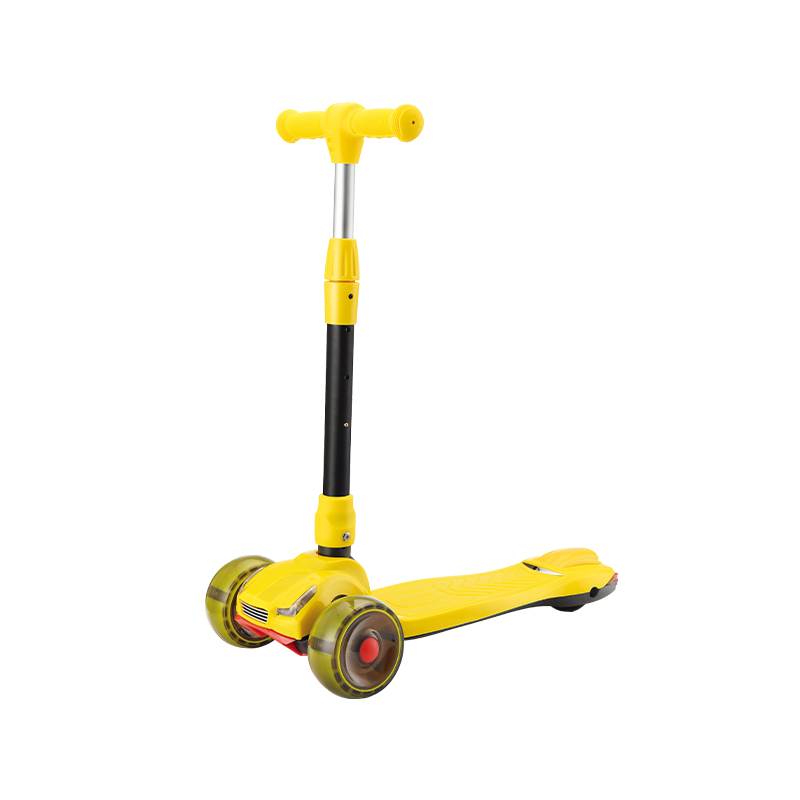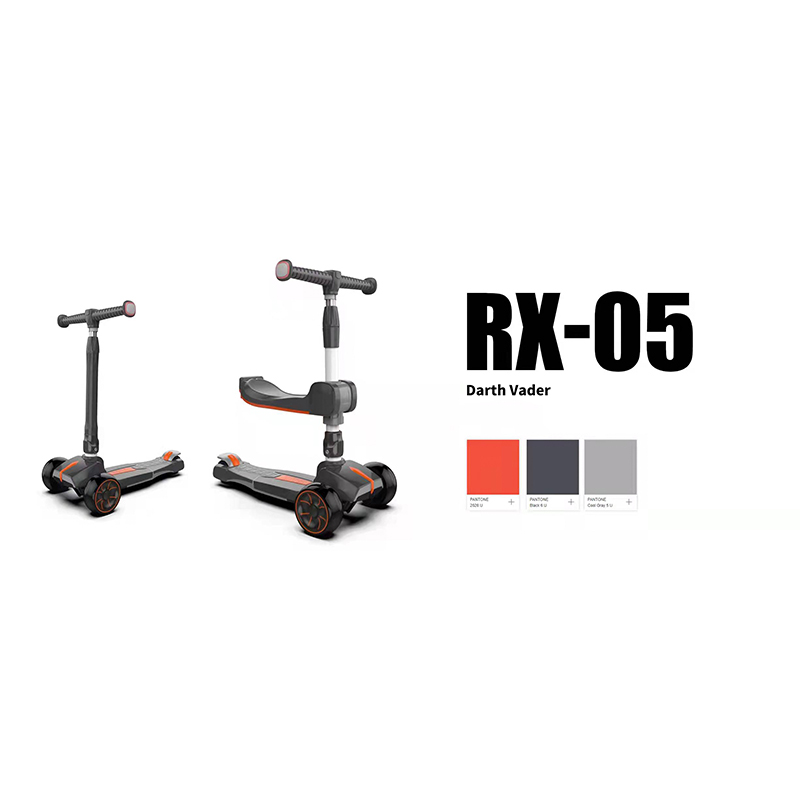Do children's kick scooters have multiple adjustable positions as children grow, extending their use and maintaining correct riding posture?
Release Time : 2025-08-28
Whether a children's kick scooter features multiple adjustable positions as a child grows is a key indicator of its user-friendly design and whether it truly meets the needs of children's growth. A child's body undergoes significant changes over the years, from the tenderness of a first step to the agility of a free runner. Each increase in height presents new demands on the riding tool. A kick scooter that fails to adapt to these changes often becomes unused quickly due to handlebars that are too low, pedals that are too close to the ground, or difficulty in maneuvering. This not only wastes resources but also potentially affects the child's riding experience and coordination due to improper posture.
The core value of a kick scooter with multiple adjustable positions is "growth-accompanying." The adjustable handlebar system allows parents to flexibly adjust the handlebar height based on their child's actual height and arm length, ensuring that when standing and scooting, their arms are naturally extended and their shoulders are relaxed, allowing them to easily steer without bending or shrugging. This ergonomic design not only improves control comfort but also reduces fatigue from extended riding, encouraging children to actively participate in outdoor activities.
A correct riding posture is crucial for children's motor development. When the handlebars are at the right height, a child's center of gravity naturally rests on the center of the pedals, allowing them to maintain an upright or slightly forward lean, maintain a clear field of vision, and improve their reflexes. This posture helps develop a good sense of balance and spatial awareness, a crucial step in early athletic development. Conversely, if the handlebars are too low, children are forced to lean forward, which not only affects their breathing and vision but also increases the risk of falls due to poor control. If the handlebars are too high, the arms are excessively lifted, straining the shoulders and neck, making it difficult to maintain stable steering. Multiple adjustment levels are designed to mitigate these risks, ensuring every ride is safe and comfortable.
The design of the adjustment mechanism also reflects the quality of the product. High-quality kick scooters utilize quick and stable lifting systems, such as snap-on, knob-lock, or hydraulically assisted, for easy operation and tool-free height adjustment. The locking mechanism must be secure and reliable, preventing it from coming loose due to vibration or external forces during riding, ensuring stability and control when accelerating, turning, or navigating uneven surfaces. Furthermore, the adjustment range must cover the common height range of toddlers to school-age children, allowing the product to adapt to multiple growth stages and truly achieve "one vehicle for multiple uses."
Adjustability also extends to other components. Some high-end models offer fine-tuning of the pedal width or wheelbase to accommodate different foot shapes and riding habits. The combination of folding functionality and weight control makes the Kick Scooter highly portable for family travel, making it a breeze to carry in a car trunk, on the subway, or tuck away in a corner of the hallway.
From a family perspective, multiple adjustment levels significantly extend the product's lifespan and cost-effectiveness. Rather than frequently replacing a Kick Scooter with a child's age, choosing one that can grow with them reduces the cost of repeated purchases and avoids the waste of unused toys. More importantly, children develop an emotional attachment to the same Kick Scooter, and as they constantly adapt to new heights, they experience a sense of their own growth. This psychological companionship is equally valuable.
Finally, a Kick Scooter that adjusts to a child's height is no longer just a toy, but a silent companion for growth. With each rise in height, it witnesses a child's transformation from stumbling steps to confident gliding. Its intelligent structure responds to the body's changes, and its continuous adaptation safeguards the courage to explore. When a child hurls through the wind, the handlebars are at just the right height. This is not only a comfortable ride, but also a silent promise of a free and safe childhood.
The core value of a kick scooter with multiple adjustable positions is "growth-accompanying." The adjustable handlebar system allows parents to flexibly adjust the handlebar height based on their child's actual height and arm length, ensuring that when standing and scooting, their arms are naturally extended and their shoulders are relaxed, allowing them to easily steer without bending or shrugging. This ergonomic design not only improves control comfort but also reduces fatigue from extended riding, encouraging children to actively participate in outdoor activities.
A correct riding posture is crucial for children's motor development. When the handlebars are at the right height, a child's center of gravity naturally rests on the center of the pedals, allowing them to maintain an upright or slightly forward lean, maintain a clear field of vision, and improve their reflexes. This posture helps develop a good sense of balance and spatial awareness, a crucial step in early athletic development. Conversely, if the handlebars are too low, children are forced to lean forward, which not only affects their breathing and vision but also increases the risk of falls due to poor control. If the handlebars are too high, the arms are excessively lifted, straining the shoulders and neck, making it difficult to maintain stable steering. Multiple adjustment levels are designed to mitigate these risks, ensuring every ride is safe and comfortable.
The design of the adjustment mechanism also reflects the quality of the product. High-quality kick scooters utilize quick and stable lifting systems, such as snap-on, knob-lock, or hydraulically assisted, for easy operation and tool-free height adjustment. The locking mechanism must be secure and reliable, preventing it from coming loose due to vibration or external forces during riding, ensuring stability and control when accelerating, turning, or navigating uneven surfaces. Furthermore, the adjustment range must cover the common height range of toddlers to school-age children, allowing the product to adapt to multiple growth stages and truly achieve "one vehicle for multiple uses."
Adjustability also extends to other components. Some high-end models offer fine-tuning of the pedal width or wheelbase to accommodate different foot shapes and riding habits. The combination of folding functionality and weight control makes the Kick Scooter highly portable for family travel, making it a breeze to carry in a car trunk, on the subway, or tuck away in a corner of the hallway.
From a family perspective, multiple adjustment levels significantly extend the product's lifespan and cost-effectiveness. Rather than frequently replacing a Kick Scooter with a child's age, choosing one that can grow with them reduces the cost of repeated purchases and avoids the waste of unused toys. More importantly, children develop an emotional attachment to the same Kick Scooter, and as they constantly adapt to new heights, they experience a sense of their own growth. This psychological companionship is equally valuable.
Finally, a Kick Scooter that adjusts to a child's height is no longer just a toy, but a silent companion for growth. With each rise in height, it witnesses a child's transformation from stumbling steps to confident gliding. Its intelligent structure responds to the body's changes, and its continuous adaptation safeguards the courage to explore. When a child hurls through the wind, the handlebars are at just the right height. This is not only a comfortable ride, but also a silent promise of a free and safe childhood.







